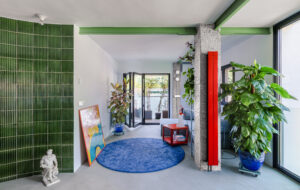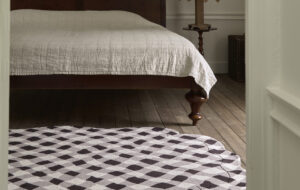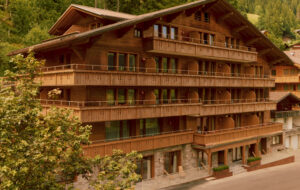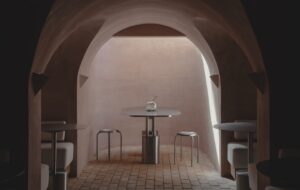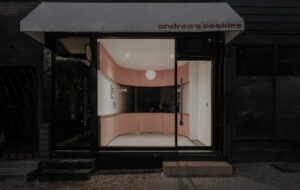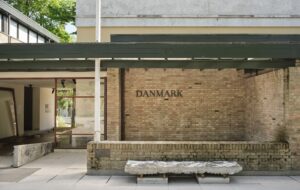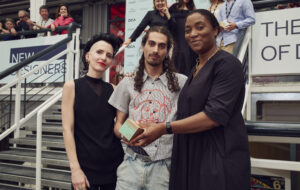


words Marcus Fairs
It’s just another rainy day in Amsterdam. On a bridge over Herengracht, the most prestigious of the four canals that ring the city centre, Nike is filming a new commercial featuring a teenage athlete who juggles footballs with his feet. A few hundred metres further on, the police are on the scene of a hit-and-run accident that has left two pedestrians dead. And in an elegant 18th-century townhouse across the canal, two young designers are showing icon the lampshades that will change the world.
The lamps, some of which look like flowers and others that look like fiendish puzzles, are made on rapid prototyping machines. These devices allow the creation of forms that would be impossible by any other means. Little surprise that Jiri Evenhuis, 30, and Janne Kyttanen, 29, call their design company Freedom of Creation.
“You can make anything you want – any shape,” says Evenhuis, picking up a lamp that looks as if it is made from several thousand tiny pieces of interlocking plastic painstakingly glued together by hand. “It’s quite a challenge to let go of your conditioning and create forms that really can’t be made any other way. It’s like when to tell a child they can draw anything: you kind of freeze at first. It requires a leap of the imagination.”
Rapid prototyping is a term used to describe a range of processes that fabricate physical objects directly from CAD files. A rapid prototyping machine is in effect a three-dimensional printer, building up solid objects from microscopic layers of metal, plastic or other materials in much the same way as an inkjet printer deposits rows of tiny ink dots on a piece of paper. In fact, 3D printing would be a far better term for the process, were it not for the fact that the phrase is the property of an American corporation. “Rapid manufacturing” is a compromise term that seems to be gaining currency at the moment, but for this story we’ll stick to rapid prototyping.
To create something using rapid prototyping, designers first create a computer file using standard 3D modelling software applications such as Solidworks or 3D Studio Max. The file is then fed directly into the rapid prototyping machine, which fabricates the object by firing a laser into a chamber of raw material – usually plastic or metal. The laser solidifies a tiny layer of material at a time, slowly building up a three-dimensional object.
The technology is in its infancy but it raises the possibility of manufacturing on demand, with one-off objects or large production runs produced when they are needed. “It’s a new technology that will eventually revolutionise manufacturing,” says Evenhuis.
“At the moment there’s a big problem with the logistics of production,” says Kyttanen. “There’s always over-production or under-production. You have a factory in Taiwan, you make a million cups or whatever, you ship them all around the world, you store them in warehouses, you employ tons of people. It’s crazy. But with this, you can have just-in-time production. You don’t need investment – only the cost of the machine and the time it takes to create a file.”
Kyttanen, who comes from Finland, began experimenting with rapid prototyping while studying industrial design in Barcelona in the mid-Nineties. The technology was at that time beginning to be used by industrial designers to produce prototypes for new products – hence the name. Today it is a billion-dollar industry: car manufacturers use the machines to mock-up new designs for bumpers and wing-mirrors, for example, and everything from mobile phones to surgical instruments are evaluated this way.
But few designers have thought to use the process to create finished products. And even fewer have exploited the machines’ ability to “print” shapes that would be impossible to make using traditional manufacturing processes such as moulding or pressing. Because of the way forms are built up from layers, the machines can create objects inside other objects, objects with deep recesses or undercuts, or objects comprising numerous interlocking forms.
After graduating, Kyttanen completed a masters degree at the Rietvelt Academy in Amsterdam, where he met Amsterdam-born Evenhuis and introduced him to the technology. “I was blown away,” Evenhuis recalls. “It wouldn’t let me go.”
Kyttanen and Evenhuis set up Freedom of Creation and built a relationship with Belgian rapid prototyping company Materialise, borrowing time on its machines to produce small objects including lights and jewellery. Materialise had pretty much cornered the European market in prototype production and was looking for new uses for its machines.
However, Freedom of Creation’s first objects worked out to be prohibitively expensive to produce. A rapid prototyping machine costs around £500,000 and to use one for an hour will cost you about £40. And despite the name, the process is not particularly rapid – it takes about six hours to fabricate something as simple as a lightshade, which then has to be left to cure for several more hours.
“The machines have never been developed to be speedy,” says Kyttanen. “They leave the machine running when they go home at 6pm, and it keeps going all night.”
To save production time, the duo started to design objects that nested together: table lamps that fitted inside floor lamps, for example. Then they began to experiment with collapsible forms – objects composed of interlocking links that squashed down to minimise production time and then could be concertinaed out to full size. This led to a breakthrough: Evenhuis realised that they could create fabrics made up of thousands of tiny, interlocking pieces. The fabrics would not need to be produced on a flat plane but instead could be manufactured scrunched up to achieve the most efficient use of the rapid prototyping machines. “I realised you could make something large in a small space,” says Evenhuis.
The problem was, nobody else believed it was possible. “When we first told them about the fabric, the manufacturers didn’t think they could do it,” recalls Evenhuis. “So Janne sneaked one into one of the machines and when it was finished, their jaws dropped.”
Materialise was so impressed that it decided to give FOC a year’s funding to see what else they could come up with.
Kyttanen produces a box full of fabric samples: some are made of tiny circular links like fine chain mail; others of endless spirals of matter; others again resemble knitted spaghetti. They produce another box with some of the results of their experiments: watch straps and jewellery made from a mixture of nylon and aluminium. “So you can have flexible aluminium,” says Kyttanen. “You come across things accidentally. It’s like being a five-year-old again.”
Kyttanen and Evenhuis decided to focus their efforts on the fashion industry, hoping to team up with a leading fashion house to market their fabrics. The potential is incredible: by supplying their dimensions, customers could have items of clothing tailor-made for them. The rapid manufacturing machine would be able to build the packaging around the completed item, and could even write the customer’s name and address on the box. The computer code used to create the item could be supplied along with the clothing on a CD, so the owner could order an identical copy simply by emailing the factory.
However, fashion designers proved somewhat reluctant to adopt the technique and with just a few months of funding remaining, FOC have decided to concentrate on marketing their more straightforward lamps – which they are preparing to market at around £200 each – and to leave their conquest of the fashion world for later.
One potential application that they are toying with, however, is somewhat more prosaic: butchers’ protective gloves. “At the moment, they’re made one by one out of metal by a Chinese man,” says Evenhuis. “Instead, they could be made from fabric printed by rapid manufacturing machines. The butcher could scan his hand – or even photocopy it and fax it to us – and we could make the glove to fit.”
FOC believe that this is just a foretaste of what is to come. They foresee the day when rapid prototyping machines will be faster, cheaper and more versatile than today, resulting in a profound change in the way objects are manufactured. Kyttanen gives a simple example: “If your washing machine breaks down, you could go on to the manufacturers’ website, choose the component you need and it will send the info to a 3D printer near where you live.”
Kyttanen believes that the technology will one day be ubiquitous, comparing it to the way that computer printers have given universal access to printed documents. Evenhuis even foresees a time when you won’t need to take luggage on holiday with you. “You’ll take a miniature hard drive the size of a keyring, containing data that will allow you to ‘print’ everything you need when you get to your destination,” he says.

